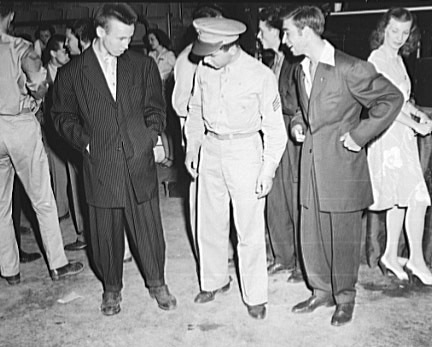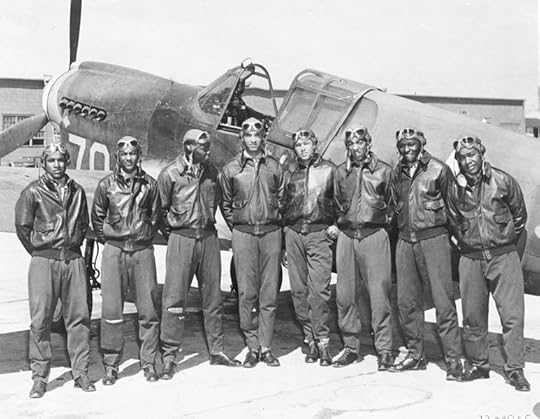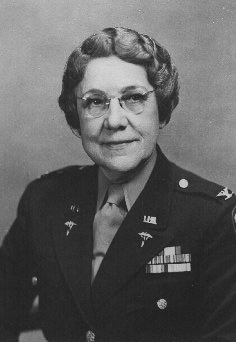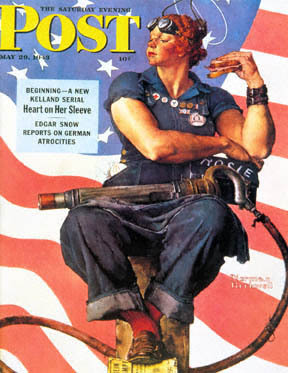Sarah Sundin's Blog, page 91
June 4, 2023
Today in World War II History—June 4, 1943

US poster for United China Relief, WWII
80 Years Ago—June 4, 1943: Luftwaffe bombs Gorky, Russia, in first German strategic air raid against Soviet industrial centers.
Chinese troops launch assault against Japanese in the Hubei-Hunan region of China.
The post Today in World War II History—June 4, 1943 first appeared on Sarah Sundin.June 3, 2023
Today in World War II History—June 3, 1943

Soldier inspecting zoot suits at the Uline Arena, Washington, DC, 1942 (Library of Congress: LC-USF35-1326)
80 Years Ago—June 3, 1943: Zoot suit riots begin—US Navy sailors attack Mexican-Americans in Los Angeles, as servicemen resent flamboyant “unpatriotic” clothing of Latino youth; over the next several days over 150 people will be injured.
French Committee for National Liberation is formed in Algiers, Algeria, under joint leadership of rivals Gen. Charles de Gaulle and Gen. Henri Giraud.
Patent is filed by American engineer Hurley Smith for the first plastic pocket protector.
Jean-Paul Sartre’s first play, Les Mouches, premieres at Théâtre de la Cité in Paris.
The post Today in World War II History—June 3, 1943 first appeared on Sarah Sundin.June 2, 2023
Today in World War II History—June 2, 1943

Men of the US 99th Fighter Squadron (“Tuskegee Airmen”) and a P-40 fighter in North Africa, 1943 (US Air Force photo: 25502027)
80 Years Ago—June 2, 1943: Combat debut of US 99th Fighter Squadron, the first Black unit in the Army Air Force (“Tuskegee Airmen”), in a Twelfth Air Force mission from Tunisia to the island of Pantelleria.
The post Today in World War II History—June 2, 1943 first appeared on Sarah Sundin.June 1, 2023
Today in World War II History—June 1, 1943

Publicity photo of Leslie Howard for Gone with the Wind, 1939 (public domain via Wikipedia)
80 Years Ago—June 1, 1943: German Ju 88s shoot down a DC-3 airliner flying from Portugal to England, killing 17, including British actor Leslie Howard (Gone With the Wind) and Wilfrid Israel, a German Jewish businessman who played a significant role rescuing Jews from the continent; Howard once told Israel, “You are the Scarlet Pimpernel. I’ve only played the part.”
Col. Florence Blanchfield becomes superintendent of the US Army Nurse Corps. (See my four-part series on the US Army Nurse Corps in World War II).
Frank Sinatra signs with Columbia Records as a solo artist.

Col. Florence Blanchfield, US Army Nurse Corps (US War Department photo)
The post Today in World War II History—June 1, 1943 first appeared on Sarah Sundin.May 31, 2023
Today in World War II History—May 31, 1943

Allied air raid on Pantelleria Island in the Mediterranean, May-June 1943 (US Army Center of Military History)
80 Years Ago—May 31, 1943: British ships begin naval bombardment of island of Pantelleria between Tunisia and Sicily, adding to the aerial bombardment started May 18.
Movie premiere of Cole Porter musical Du Barry Was a Lady, starring Red Skelton, Lucille Ball, Virginia O’Brien, and Gene Kelly.
“Archie” comics are first broadcast on the radio.
The post Today in World War II History—May 31, 1943 first appeared on Sarah Sundin.May 30, 2023
A Tribute to Rosie the Riveter

Rosie the Riveter has come to represent the women of World War II. We all love Rosie. She’s strong but cute. She has biceps, but she curls her hair and does her nails. And look at that chin—she won’t let anyone tell her what she can or can’t do. She is woman; hear her riveting gun.
The 1940 census counted 132 million people in the USA. During the war, 11 million men and women served in the armed forces. Even if the economy had continued at its pre-war level, that would have caused a significant drop in the workforce. But with the enormous increase in production, more workers were desperately needed. And that meant women.
Recruiting Rosie
US poster, 1943 (US Office of War Information O-520464)
American industry actively recruited women to work in war jobs, and women’s war work was praised in songs, posters, advertisements, and movies.
The song “Rosie the Riveter” (Redd Evans/John Jacob Loeb, copyright 1942) most likely invented the term of “Rosie the Riveter.” The popular song praised the girl on the assembly line and was recorded by Kay Kyser, the Four Vagabonds, and others.
The “We Can Do It” poster by J. Howard Miller was introduced February 15, 1943 for a two-week in-house campaign at Westinghouse. At the time, the poster wasn’t seen nationwide, nor was it associated with “Rosie.” Not until the early 1980s was the poster rediscovered and embraced – and connected with Rosie.

US poster by J. Howard Miller, 1943 (Library of Congress: 2021669753)
On May 29, 1943, Norman Rockwell’s “Rosie the Riveter” painting appeared on the cover of The Saturday Evening Post, most likely inspired by the song. Rosie’s foot stamps out Hitler’s Mein Kampf, a riveting gun lies across her lap, and “Rosie” is printed on her lunchbox. On April 9, 1944, a feature film called Rosie the Riveter was released, starring Jane Frazee.

Norman Rockwell’s “Rosie the Riveter” on the cover of the Saturday Evening Post, 29 May 1943 (Fair use via Wikipedia)
Rosie the Riveter has come to represent all women who contributed to the war effort by stepping into men’s work boots.
Challenges for Rosie
US poster recruiting Women Ordnance Workers, WWII
During the war, 19 million women held jobs outside of the home, up from 12 million in 1940—6 million were working outside the home for the first time. Thirty percent of working women worked in factories as Rosie the Riveter and Wendy the Welder and more. At first, they faced much opposition. Some believed women wouldn’t be capable of performing men’s jobs, and some were even convinced the women were there to seduce the men. However, Rosie and her friends proved to be able workers—and were even preferred in some jobs that benefitted from women’s smaller fingers and attention to detail.
They faced other challenges. While 2.75 million working women had children under the age of fourteen, day care was not available early in the war. Mothers relied on relatives or friends—or left the children unattended. Movie theaters reported an unsettling trend of young children left all day at the movies unsupervised. Savvy employers began to provide on-site day care, and centers were also established at schools.

US poster by J. Howard Miller, WWII
Women struggled for equal treatment. Although the War Labor Board decreed in April 1943 that women in war jobs were to receive equal work for equal pay, the average wage for female workers remained significantly lower. As the newest employees on the job, women lacked seniority under union rules and were often stuck with the swing swift—an extra problem for mothers with young children at home.
Honoring RosieWomen played an important role in the extraordinary increase in production during the war, contributing to the “Arsenal of Democracy” that helped win the war for the Allies.

My son humoring his mother and operating the riveting gun exhibit at the Rosie the Riveter WWII Home Front Museum, Richmond, CA (May 2014)
Today Rosies are honored at the Rosie the Riveter WWII Home Front National Historical Park in Richmond, CA, located at the site of the Kaiser Shipyards where many of these women worked. The museum has excellent exhibits about women at work—and many Rosies serve as docents!
Here’s to all the Rosies! They could do it!
Selected sources:Lingeman, Richard R. Don’t You Know There’s a War on? The American Home Front 1941-1945. New York: G.P. Putnam’s Sons, 1970.
Library of Congress video about Rosie the Riveter.
The post A Tribute to Rosie the Riveter first appeared on Sarah Sundin.Today in World War II History—May 30, 1943

Map of US Army operations on Attu in the Aleutians, May 1943 (US Army Center of Military History)
80 Years Ago—May 30, 1943: US Army secures Attu in the Aleutians, 700 Americans and 2600 Japanese have been killed (only 29 Japanese surrender).
Dr. Josef Mengele, “the angel of death,” arrives at Auschwitz.
All-American Girls Baseball League begins its first 108-game season with four teams (Rockford, Kenosha, Racine, and South Bend).
The post Today in World War II History—May 30, 1943 first appeared on Sarah Sundin.May 29, 2023
Memorial Day – Remembering the Cost

US Navy sailors honoring fellow sailors killed during the Pearl Harbor attack, Naval Air Station Kaneohe, Oahu, 30 May 1942 (US National Archives: 80-G-K-13328)
On Memorial Day, we remember those who gave their lives in defense of our country.
We live in freedom because they fought tyranny.
We live without fear because they faced danger.
We live in comfort because they gave up all comforts.
We live because of their sacrifices.
Let’s never take these gifts for granted. They were purchased at high cost.
Over 1 million Americans have given their lives in war (Source: English, June A., Jones, Thomas D., Scholastic Encyclopedia of the United States at War, New York NY: Scholastic Reference, 1998).
American Revolution: 4,435War of 1812: 2,260Mexican-American War: 13,283Civil War: 498,332Spanish-American War: 2,446World War I: 116,708World War II: 407,316Korean War: 33.651Vietnam War: 58,168Gulf War: 293War on Terrorism (Source: icasualties.org): 4586 in Iraq, 2465 in AfghanistanOn this Memorial Day, take a moment to remember. And take a moment to thank God for freedom and life.
The post Memorial Day – Remembering the Cost first appeared on Sarah Sundin.Today in World War II History—May 29, 1943

Norman Rockwell’s “Rosie the Riveter” on the cover of the Saturday Evening Post, 29 May 1943 (Fair use via Wikipedia)
80 Years Ago—May 29, 1943: Japanese launch a banzai counterattack on Attu in the Aleutians, which is repelled by US forces.
Norman Rockwell’s “Rosie the Riveter” appears on the cover of The Saturday Evening Post (Read more: “A Tribute to Rosie the Riveter”).
The post Today in World War II History—May 29, 1943 first appeared on Sarah Sundin.May 28, 2023
Today in World War II History—May 28, 1943

Light carrier USS Cowpens, 1945 (US National Archives: 80-G-468977)
80 Years Ago—May 28, 1943: Light carrier USS Cowpens, nicknamed “The Mighty Moo,” is commissioned at Camden, NJ.
The post Today in World War II History—May 28, 1943 first appeared on Sarah Sundin.


